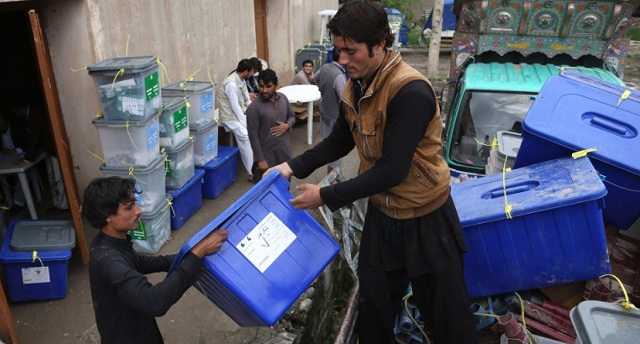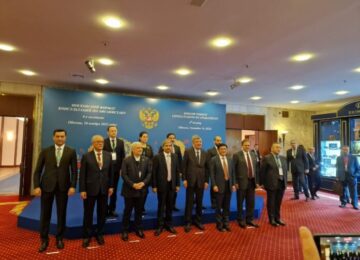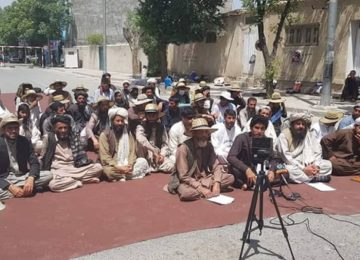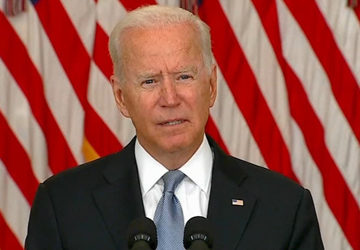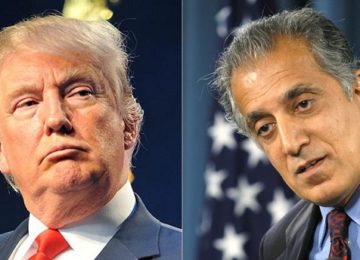One of the main goals of Afghanistan launching a new voter registration process – a key provision of the 2014 National Unity Government Agreement – was to more accurately match the number of ballot papers to the number of voters in any given area. It was hoped this would reduce the opportunities for ballot stuffing. However, a review of the registration statistics released by the Independent Election Commission (IEC) – disaggregated by province and by gender – reveal suspicious anomalies. Further vetting of the voter lists and targeted audits of suspicious areas are needed, says guest author Scott Worden,* to address rising doubts about the integrity of Afghanistan’s voter lists. AAN has put together a dossier of dispatches related to the coming elections, looking at preparations and political manoeuvring. Each dispatch in Election Conundrum series will be added to it.
Voter registration has long been a weak point undermining the integrity of Afghan elections. The results of the 2009 and 2014 presidential elections and 2010 parliamentary elections were all highly contested because of mass ballot stuffing – with between 10 and 25 per cent of the ballots thrown out because of fraud by the Afghan electoral authorities. That ballot stuffing was enabled in part by the availability of excess ballot papers which had been sent to areas with no independent election observers – because they were insecure, or sometimes also because they had been politically captured by local strongmen. In the 2014 election, there was an estimated total number of voters of around 12 million and 23 million voter cards in circulation (read this USIP report). Eliminating this huge discrepancy was a key goal of the voter registration reforms identified in the 2014 National Unity Government Agreement between Ashraf Ghani and Abdullah Abdullah.
The National Unity Government Agreement (full text here) and the Special Electoral Reform Commission (see AAN background here and here) in 2015 pinpointed the need to get rid of the fake and duplicate voter cards in circulation and tie voters to specific polling centres where they are required to cast their ballots.
The Afghan government initially considered issuing biometric voter registration cards that would include detailed photographs and the fingerprints of each voter. However, this involved tough technical challenges and would be a years-long process to fully implement. In any case, the IEC failed to conduct a proper procurement – it yielded only one bidder that did not have a strong technical track record (see AAN’s previous reporting on debate about use of electoral technology here). The biometric ID project has yet to get off the ground.
The current approach has been to issue voter registration cards to anyone eligible who has a tazkera– the paper, non-biometric national ID card that has been issued to citizens for the last several decades. Although the tazkera is widely considered a reliable ID, a majority of eligible voters did not have one when voter registration began. The agency responsible for issuing tazkeras, the Afghanistan Central Civil Registration Authority (ACCRA), therefore planned to issue up to 10 million new ones so that eligible citizens could register to vote. (More on voter registration procedure in AAN’s previous report here.) (1)
In early August, the IEC told AAN it had registered a total number of 9,072,208 voters, including 5,783,037 men (63.7%) and 3,114,942 women (34.3%) (see here). The total preliminary number of registered voters listed on the IEC website is slightly lower, at 8,910,107 (latest published figures as of 6 July). Either number would be a remarkable achievement considering the IEC’s late start in launching voter registration, its relatively thin public outreach campaign, early low figures (see AAN’s previous reporting on initial low turnout and the government’s incentive and coercive measures to boost it, here) and, above all, conflict in much of the country and an insurgency hostile to the elections. Analysing the IEC’s statistics, particularly breaking them down by province and gender, only sharpens the suspicion that these voter registration numbers are indeed too good to be true. Analysis reveals that registration in several provinces is implausibly high, based not only on the ratio of voters to population and the levels of male and female registration, but also prevailing insecurity.
Based on an evaluation of the provincial level voter registration statistics, there are three integrity issues that deserve further scrutiny: over-registration and the risk of ballot stuffing, under-registration and the risk of disenfranchisement and low (and also questionable) female participation in the electoral process.
Evaluating the Voter Registration data
One way of assessing the recent registration drive is to compare the number of voters registered with the estimated number of eligible voters. It is estimated that half of the population is at least 18 – the minimum age to vote. But Afghanistan has never had a complete census so all population figures are estimates. For the total population, those estimates vary between 28 million and 34 million. This analysis uses the population estimate published by the Central Statistics Office (CSO) for 2016-17 of 27.7 million, which the IEC has used as the basis for its allocation of parliamentary seats and polling centres. (The CSO numbers for 2017-18 are only slightly higher at 29.7 million.) (2) But whether the number of eligible voters is actually somewhat higher or lower than the estimate is not too important; population figures that are accurate within, say, ten percent of the actual number are a useful tool to identify discrepancies that are an order of magnitude greater.
Based on the IEC’s published registration data, 65 per cent (5.8 million) registered voters were men and 35 per cent (3.1 million) are women. The curious number here is the men’s. Considering that roughly half the population is male, this means that approximately 84 per cent of all eligible men registered to vote. This seems an improbable statistic considering security conditions, a low-key voter outreach effort and a general lack of enthusiasm for elections following several past, fraud-ridden efforts.
As the tables below indicate, there is a wide range of participation rates across Afghanistan’s 34 provinces. At one end of the spectrum, Ghazni has only registered 9 per cent of its estimated eligible voting population. This can be explained by the boycott of the electoral process that has been in place since the second week of registration (see AAN analysis here). Paktia, on the other hand, has registered an implausible 141 per cent of its estimated eligible population.
The balance between women and men registering varies widely as well. Only four per cent of registrants in Uruzgan are women, one of 11 provinces where less than a third of the registrants are women. By contrast, a 57 per cent majority of registrants in Jawzjan are women. Daikundi and Bamyan also have female majorities among registered voters. It is plausible that women in Hazara and Uzbek areas would register in higher numbers because of different gender norms and/or because of savvy mobilisation by more organised political parties there. But one wonders whether amajorityof female voters reflects the reality on the ground.
Under-registration and the risk of disenfranchisement
Setting Ghazni’s anomalous 9 per cent registration rate aside, six other provinces have less than 40 per cent of eligible voters registered: Farah (26%), Badghis (31%), Kunar (33%), Uruzgan (33%) Kunduz (34%) and Faryab (38%). Six more provinces have less than half of their eligible voters registered, based on the conservative CSO population estimates, namely Ghor, Jawzjan, Wardak, Zabul, Sar-e Pul and Logar. These provinces are scattered across the country, but all face significant threats from the insurgency that would tend to reduce registration rates.
Low registration numbers are relevant because the number of votes cast will likely be even lower. It is rare, even in developed, secure countries, for more than 75 per cent of registered voters to appear on election day. If only 40 per cent of a given constituency are registered and only half of them vote, this would translate into a participation rate of just 20 per cent of eligible voters – raising questions over how much the elected members would actually represent their provincial constituencies.
Under Afghan law, there is no legal minimum threshold of votes for election results to be valid. However, there are legal requirements for citizens to have equal access to voting. If voters in a given district are effectively disenfranchised because it was difficult or impossible to register (because of insecurity, uneven distribution of registration centres, or obstacles to obtaining a tazkera for registration), then low voter registration could amount to a violation of electoral law that would have to be considered by the Electoral Complaints Commission (ECC).
The most problematic issue regarding low registration rates, however, is political rather than legal. When district-level voter registration figures are released, they will indicate more specifically where registration was high or low within a province. This can then be compared to observation reports, security conditions and past voting patterns. If registration is comparatively high in a dense urban area, or a district that has seen a lot of refugee resettlement, it may be a plausible increase. But if registration was high in low-density areas or ones with high insecurity, then an audit of the numbers would be warranted.
District-level registration information could also indicate disenfranchisement. If some districts had no registration, then they may miss out on representation in the parliament. In the past, this has been a source of ethnic and political tension and led to delays in certifying election results (most notably in Ghazni and Nangrahar provinces in 2010).
Over-registration and the risk of ballot stuffing
Improbably high registration rates present an even greater risk to electoral integrity because they point to possible fraud in the voter registration process that increases the risk of ballot stuffing.
The national average is 64 per cent of estimated eligible voters registering. Kabul province is a useful benchmark because it contains 18 per cent of total voters and is the most multi-ethnic and diverse province in the country. As such, it had a 72 per cent registration rate. The above average registration may be explained by the facts that Kabul is a relatively safe province, with a more educated population and there was good media coverage about the electoral process during voter registration. However, 13 provinces exceeded Kabul’s 72 per cent participation rate and four – Paktia, Nimruz, Nangrahar and Nuristan – saw more than 100 per cent of their estimated eligible voters registering.
There are many drivers of genuine high voter registration. They include: good IEC public outreach, adequate security, the enthusiasm and effort of candidates, elders and political parties to mobilise supporters and the accessibility of both tazkera-issuing offices and voter registration centres. This all makes it somewhat difficult to determine whether any given registration figure is reasonable or not. However, some broad assumptions can be made to focus attention on likely problem places that deserve further scrutiny.
Most obviously, security conditions have an enormous impact on valid voter registration rates. The Taleban have openly opposed elections in general and voter registration in particular (see AAN’s previous reporting here). Several attacks took place near or on voter registration centres at the outset of voter registration (see here and here). The most recent incident of this kind was a suicide attack on 25 August in front of the IEC provincial office in Jalalabad where people had gathered to protest against the exclusion of one parliamentary candidate; seven people were killed and several others injured. According to the latest Special Inspector General of Afghan Reconstruction (SIGAR) quarterly report released in July 2018, 229 of Afghanistan’ s 407 districts (56 per cent) are under Afghan government control (74) or influence (155), while 56 districts under insurgent control (11) or influence (45) (p68). The Long War Journal maintains a different list of Taleban controlled or contested districts that puts the number higher, at239 of Afghanistan’s 407 districts, or 59 per cent. In the face ofthose risks, one can expect voter registration to be low in insecure areas (see also AAN’s reporting on failure to hold district council elections here).
Despite this, several of the highest rates of registration can be found in some of the most insecure provinces, including Paktia, Nimruz, Nangrahar, Nuristan, Baghlan, Kandahar, Khost and Kunduz. All of these saw registrations higher than in Kabul, which is more secure and has a greater saturation of public information on the election process. Moreover, the IEC was unable to open many registration locations across those provinces. In the previous elections of 2014, 2010 and 2009, audits of ballot boxes in most of these provinces also revealed high rates of fraudulent voting. All these factors raise questions about whether the registration was conducted properly there.
Another way to identify implausibly high voter registration is to examine registration rates by gender. Given that roughly half of the population has reached the eligible voting age of 18 and half of that population is male, then a quarter of the CSO population estimates are eligible men. Using those numbers, one finds that ten provinces have more than 100 per cent of eligible men registered. Of those, Paktia has an astonishing 164 per cent and Kandahar and Nimruz more than 150 per cent. Factoring in poor security conditions in all of those provinces, the plausibility of such robust participation disappears completely. While population figures in Afghanistan are not precise, the over-registration of men in these provinces is highly suspicious. (3)
Fraudulent registration is a problem in parliamentary elections if it occurs in some districts of a province more than others, thereby giving an advantage to candidates who can mobilise voter blocs in the high-registering districts.
Questions about female registration
Increasing women’s participation in Afghan elections has been an elusive goal. While it is not easy to compare current and past registration rates because the voter registration process has changed, the current numbers suggest that fewer women have registered to vote this time. The ratio of female to male registrants in the 2004 and 2010 elections was roughly 40:60 per cent, whereas the figure now stands at 34:66 per cent. (4) In both cases, however, there is a caveat that there have been widespread allegations of proxy registration (and proxy voting) on behalf of women that were difficult for past audits of election results to prove or disprove (also see this AAN reporting from 2014).
Provinces that conform to the assumption that female registration will be low in conservative and/or insecure provinces include Uruzgan, with only 4 per cent female registration, followed by Helmand (13%), Kandahar (13%), Zabul (15%), Paktika (20%), Wardak (21%), Khost (26%) and Logar (27%). Also conforming to the norm, the areas with the highest female participation rates are in provinces with Hazara or Uzbek majorities (Jawzjan 57%, Daikundi 55%, Bamyan 51%, and Sar-e Pul 49%), reflecting cultural norms that tend to be less restrictive for women. That said, it still seems unusual to have any provinces with a majority of female registration.
Provinces that defy conventional wisdom and may deserve further scrutiny of female voter registration include Baghlan, Nuristan and Paktika, which all have above-average female registration despite poor security that tends to reduce female participation. In these cases, suspicion does not mean guilt, but additional scrutiny of the polling centre numbers and checking of these against accounts of observers would be warranted. Once more detailed information is released on registration at the district level, it will be interesting to compare urban to rural female registration against expectations that women in urban areas would have greater participation.
How to fix the voter registry
A consortium of political parties has already protested that voter registration has been inaccurate, unprofessional and “a tool to pave the way for corruption and crisis” (media report here). They argued that the current voter registration effort should be scrapped in favour of biometric IDs, which, they say, would be much harder to fake. While this might be true and was the goal of voter registration reform in 2015, it would be impossible to carry out in the short time remaining before the parliamentary election on 20 October or even before the April 2019 presidential election. (See AAN’s previous report on other party demands here and here.)
Another way that could help improve confidence in the voter registry would be for the IEC to conduct an audit of the voter lists to determine whether registrations were valid. An audit would need to check two aspects of the voter list. First, are there duplicate registrations across polling centres, which could allow people to vote more than once? Second, are the tazkeranumbers entered on the voter list valid, that is, do they correspond to the records kept separately by ACCRA linking each verified name and tazkera number to the voter list? If duplicate or fake names are entered onto the final voter list, then excess ballots will be sent to polling stations and be available for ballot-stuffing.
To conduct either of these audits, the IEC needs first to complete data entry of its voter registration database. So far, only approximately four of the nine million voter cards that have been issued have been entered into the IEC’s central database. At the current rate of data entry, it will be very difficult for the IEC to complete this before Election Day. It is therefore imperative that the IEC find ways to increase data entry of its voter registration information.
In addition, the IEC would need to check whether the unique tazkera numbers that are recorded on voter lists are valid. This would require ACCRA, the custodian of tazkera records, to complete its own database of tazkera numbers so that voter IDs and tazkeras could be cross-checked. (5) It is unclear whether ACCRA has such a database (see also this AAN’s summary piece). It is therefore imperative that ACCRA share information on how its records are stored and how many records of different types it has.
If the IEC and the ACCRA databases cannot be automatically searched, it should still be possible to do manual checks of tazkeraand voter ID numbers through random sampling in the most high-risk areas – where the ratio of population to registration seems the most suspicious. If some provinces have their data entered earlier than others, checks could be initiated there first.
Of course, such an audit, even if there is the time and political will to carry it out, might still not result in greater confidence in the voter registry. The findings might be ambiguous, or unambiguous but difficult to address. Also, if tazkera ledgers were used fraudulently during registration and names and numbers from an old ledger were used without that individual appearing at the registration centre, excess ballots could still now be sent to the polling centre and be available for ballot stuffing. Nevertheless, even at this late stage, an audit does remain one option for attempting to clean up the voter lists.
The consequences of a questionable voter registry
Even if no audit is conducted of voter registration, there will still be an opportunity for candidates and voters to assess the quality of the voter list. By law, the IEC is obliged to publish preliminary voter lists before the election. (6) This should be followed by a ‘challenge period’ during which voters, political parties and candidates can question the validity of the voter lists. Those challenges should then be adjudicated by the IEC and ECC.
Publishing specific polling centre lists that identify exactly how many people are registered in each location would also reveal important information on how voter registration breaks down on a district level. It could become clearer whether registration was plausible, based on local population and security conditions. It would also show where voters may have unfair or unequal access to the polls.
Even on election day itself, it would be difficult, but not impossible to mitigate the consequences of a questionable voter registry. It would require integrity and independent observation at polling centres on election day.
To try to get as clean an election as possible, emphasis will have to be placed on 1) hiring polling staff that have integrity, 2) ensuring good training, 3) developing convincing accountability measures for staff caught cheating and 4) having independent election observers and diverse candidate agents at as many polling centres as possible on election day – although there are not enough observers to cover many locations. In other words, good people doing the right things could overcome even questionable voter lists. However, given Afghanistan’s track record on elections, that would seem an unlikely scenario.
As with previous elections, Afghanistan faces a dilemma trying to hold credible elections in an immensely insecure environment with opaque census data: because of insecurity and low women’s registration, even if there was no fraud in the insecure areas, they would be disenfranchised relative to areas with safer access to the ballot box for voters. However, if there is ‘too much’ fraud in insecure areas – where the insecurity and paucity of observers helps ballot stuffers, they will out-vote the secure areas and win more seats than is perceived to be their due.
Possible impact on the 2019 presidential poll
The ultimate consequence of using a bad voter list for the parliamentary election is that it will undermine the credibility of the politically more significant presidential election. There are already credible complaints by candidates and observer groups about the voter lists. There will almost certainly be even louder complaints about the results after the election unless the voter rolls can be validated as clean. Then the task becomes even more difficult to clean up voter lists that have already been used in one election with just six months to go before an even bigger one.
In fact, stuffed voter lists are an even greater problem for the presidential election because, if they result in perceived ethnic or regional imbalances, it will again call the legitimacy of this vote into question. Abdullah Abdullah and Jamiat-e Islami complained bitterly after the 2014 election about alleged inflated ballot totals in southeastern provinces, which show high percentages of registered voters now. If there is no audit of registration before the presidential election, it will tee up the same complaints for a second election in a row.
* Scott Worden is Director of Afghanistan and Central Asia Programs at the U.S. Institute of Peace in Washington, DC (USIP). He has worked for or observed each of the past four Afghan elections and served as an international commissioner on the Electoral Complaints Commission in 2009.The views expressed are those of the author and should not be attributed to USIP, which does not advocate specific policy positions.
In September 2010, Scott guest-authored “Why the West should care about Afghan election fraud” for AAN.
Edited by Martine van Bijlert, Kate Clark and Thomas Ruttig
(1) However, ACCRA has no system for removing duplicate tazkeras or regularly cleaning up the tazkera registry when someone moves or dies. Therefore, many citizens have more than one tazkera issued in different provinces or at different times that could potentially be used to register multiple time to vote. It is also possible that corrupt officials could use old tazkera logs to create registrations for dead people or those who have moved. Finally, ACCRA has not yet released data on what are reported to be the five million new tazkeras issued this year during voter registration which would enable a proper evaluation of the registration.
(2) Other, non-official sources put the number higher. The CIA World Factbook has an overall population of 34 million in 2017. A satellite-based survey of population completed in 2017 called Flowminder put the overall population at 34 million. Each methodology can be debated in the absence of a full census, which has not been completed since the 1970s. However, CSO figures have been the accepted standard for the IEC in each of the post-2004 elections and are the most acceptable politically.
(3) Similar findings came up in or after previous elections. In the run-up to the 2004 presidential elections, the total number of distributed voter cards (10.5 million) exceeded the total number of estimated voters (9.8 million). This was most pronounced in the east and southeast, where in four provinces – Nuristan, Khost, Paktia and Paktika – registration reached an impressive 140 per cent of the number of estimated voters (see AAN’s 2009 report “How to win an Afghan election“, p19).
Paktika became particularly famous during the 2005 elections for being the most blatant case of over-registration and female proxy voting. In 2005 almost 160,000 registrations were added to the earlier total of 342,000 (which had already represented 140% of the estimated total voters in the province). The implausibly high proportion of alleged female registration in Paktika – 46.5% in 2004 and over 57% in 2005 – despite highly conservative cultural norms, was welcomed as a major achievement. … Interviews in the aftermath of the elections suggested that the manipulation in Paktika was by no means an exception, although it had been taken to the extreme there (p 20-1).
In 2009, there were even higher proportions of female registration than in 2005. In Nuristan, Khost, Logar and Paktia, respectively 71%, 68%, 66% and 62% of the total registrations were ‘female voters’, while Paktika still registered 50% women. There are moreover indications that the practice of female over-registration has spread to other provinces. (In provinces like Kandahar, Farah, Ghazni, Kapisa and Panjshir, there were implausibly high proportions of female registrations in selected districts, but it was not widespread enough to bring the provincial total over 50%. Some northern districts also showed signs of female over-registration, but the number of districts and excess votes was much more limited than in other provinces.) (p 21)
2014 registration figures have shown similar suspicious patterns – high female registration in conservative areas and relatively high registration figures relative to the population, particularly in insecure areas – although the patterns have not been as pronounced as in, for instance, 2009. The provinces with the highest rates of female registration were still largely in the conservative southeast: with the exception of Daikundi, 48%, the highest were in Paktika (47%), Nuristan (44%) and Paktia (43%). Kabul had 33% female registrations (see AAN’s 2014 report “What to Watch in the Elections (1): Voter registration”).
(4) In 2004, which was the last voter registration exercise conducted from scratch (although under different social and security conditions), there were 10,500,000 registered voters of which 4,336,500 (41.3%) were women (here, p8). In 2009, the ratio of registered female voters was given with 38 per cent, as compared to 42 per cent in 2004 (see here, p 4). In 2010, 35 per cent of the 3.7 million newly distributed voter cards were for women (see here); women participation was given with around 40 per cent (see USIP report here).
(5) ACCRA has two kinds of records relevant to voter registration. The first are the handwritten ledgers that go back decades indicating who has been issued with tazkeras in any given district. These are reportedly being optically scanned, but not in a computer-searchable format. ACCRA has also recorded the new tazkeras issued since voter registration began. No data has been publicly released on how many new tazkeras have been issued. Nor is there information on where the new tazkeras have been issued. Nor is it clear whether the new records are in a searchable database
(6) Article 72 of the Electoral Law states:
The Commission shall record the voters list in the National Data Centre (Database) of the Commission and, in compliance with the electoral calendar, make it accessible to the public in the relevant polling centres for their awareness and objections
By Special Arrangement with AAN. Original link.
Disclaimer: Views expressed on this blog are not necessarily endorsed or supported by the Center for Research and Security Studies, Islamabad.



